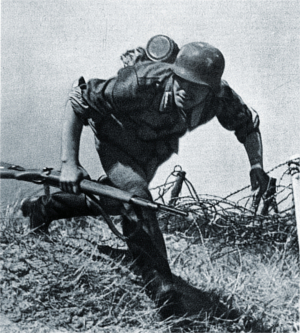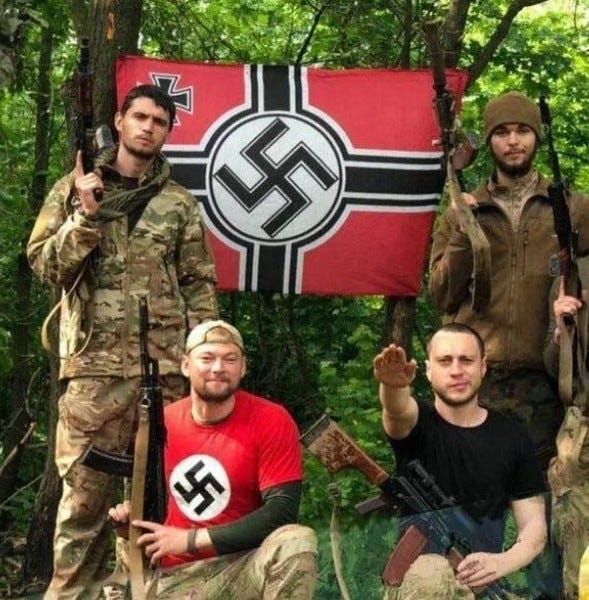With eyes on Mariupol in the early days of the war, the western media mostly abandoned any remaining concern and curiosity about neo[fascists] in the Azov Regiment (and other Azovite units). Hundreds of Azov fighters, in addition to other soldiers and civilians, held out for weeks in the city’s massive Azovstal Iron and Steel Works. New York Times reporter Michael Schwirtz, a winner of the Pulitzer Prize, called it “Ukraine’s version of the Alamo.”
In “The Battle for Azovstal,” a podcast episode by the New York Times, Schwirtz claimed that “this group has a very complicated history going back to 2014,” when Andriy Biletsky, an infamous neo[fascist], founded a “battalion of misfits” that welcomed everyone. “Anybody who wanted to could join […] And, very, quickly, the Azov Battalion became associated with a band of far-right nationalists bordering on fascists.” But this was just “a small contingent of people,” and an “association that the Azov Battalion had in its infancy.” Or so they said…
As I’ve said before, the New York Times is a case study in the western media’s whitewashing of the most powerful neo[fascist] movement in Ukraine, and probably the world. Andrew Kramer, the Kyiv bureau chief for the NYT, appears to have been its first reporter to describe the “Azov group” as anything other than a “pro-Ukrainian paramilitary” force, a “militia fighting in the east,” or “one volunteer unit.” In 2015, Kramer wrote that Azov is “openly neo-Nazi.”
In early 2022, the NGU Azov Regiment was still “far-right,” according to the New York Times. On February 25, the day after Russia attacked Ukraine, the NYT worried that Azov “has drawn far-right fighters from around the world.” Over the next month, the Times said this “far-right military unit” is “known for having neo-Nazi sympathizers but remains a fringe presence in the country and its military.” That spring, amidst the Russian siege of Mariupol, the ideology of the Azov Regiment started to become past-tense in the “newspaper of record,” for example: “the Azov Battalion … was founded as a far-right volunteer unit.”
During the second half of April, Azov evolved from “a force that does include far-right soldiers, some of them foreign, including white supremacists and people who have been described as fascists”; to “a highly skilled and controversial unit” that is “filled with far-right fighters”; to “a force that does include nationalist soldiers, which the Kremlin has used to paint the unit as fascist”; and finally, a complicated unit “whose history as a far-right group has helped fuel Russia’s largely false claim that it is fighting fascists in Ukraine.” The Times settled on a phrase about Azov’s “history” that it repeatedly deployed. The far-right “roots” of the unit “lent a veneer of credibility” to Russian propaganda.
In May 2022, one might have read in the New York Times, “Though the Azov Battalion was founded in 2014 out of Ukraine’s ultranationalist and neo-Nazi groups, experts say the group has quelled much of its extremist side under pressure from authorities.” Around that time, the NYT conducted a soft-ball interview with Lt. Illia Samoilenko, “an intelligence officer who speaks fluent English, [and] seemed intent on defining the legacy of the Azov Battalion.”
“We know about our past,” he said. He acknowledged the Azov regiment’s “obscure” origins and its past association with far-right extremists — something he said the group had shed when it became part of the national military. Independent military analysts and experts who study the far right support that assertion, saying that Azov’s incorporation into the regular combat forces of the Ukrainian military led to a purging of extremist elements. Lt. Samoilenko said lingering public misperceptions about the battalion could explain why the group did not get as much support as it might have in the run up to the war.
Some so-called experts might “support that [evidence-free] assertion,” but the New York Times must have known this was hardly the consensus among those who study the far-right in Ukraine. The Times did not bother to fact-check Samoilenko, and subsequently began to describe Azov as “a former far-right militia” with ambiguous “connections to far-right movements” and “a hard-core contingent” that has “far-right origins.” The newspaper became a broken record when it mentioned “the Azov regiment, whose roots in far-right movements have offered a veneer of credibility for Mr. Putin’s tenuous claims that Ukraine has been infected with Nazism.”
As for Samoilenko, better known as “Gandalf,” he once told a Czech reporter, “I don’t believe in any Holocaust, it’s just a story.”
I’m just a story, too.



I meant your childhood. That was very painful to read. Thank you for trusting me enough to share that with me. I feel a mix of complicated emotions and memories.
I very much appreciate your posts and am glad you share them. Not so long ago the good people of .ml taught me the difference between “left” and “liberal.” And it’s frustrating to see history rewritten to downplay the contributions of communists in Afghanistan and the second World War.